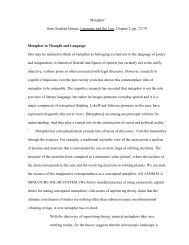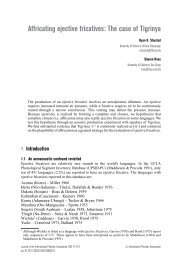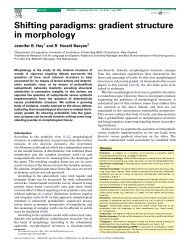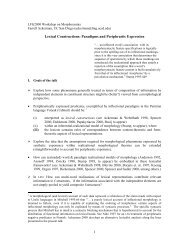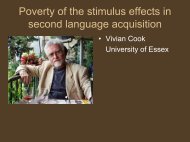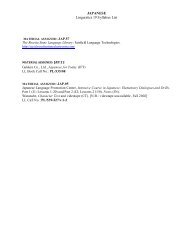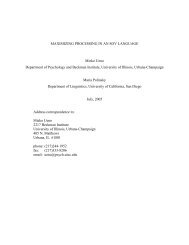Morphophonological properties of Moro causatives* - Linguistics
Morphophonological properties of Moro causatives* - Linguistics
Morphophonological properties of Moro causatives* - Linguistics
Create successful ePaper yourself
Turn your PDF publications into a flip-book with our unique Google optimized e-Paper software.
This printout has been approved by me, the author. Any mistakes in this printout will not be fixed bythe publisher. Here is my signature and the date ___________________<strong>Morphophonological</strong> <strong>properties</strong> <strong>of</strong> <strong>Moro</strong> causatives *Andrew Strabone and Sharon RoseUniversity <strong>of</strong> California, San Diego1. IntroductionIn this paper we describe and analyze the morphophonological <strong>properties</strong> <strong>of</strong> the causativeconstruction in <strong>Moro</strong>, a Kord<strong>of</strong>anian language spoken in the Nuba Mountains <strong>of</strong> Sudan. We identifyseveral phonological processes associated with the causative and demonstrate how these processesrelate to the causative morpheme’s position within the derived stem, a constituent familiar from Bantulanguages (Downing 2000). Both Kord<strong>of</strong>anian and Bantu languages belong to the larger Niger-Congophylum.The causative suffix is /-i/, added after the root. An illustration <strong>of</strong> its <strong>properties</strong> are shown in (1)with a sample verb root nat̪ ‘taste’. The imperfective and perfective are composed <strong>of</strong> the 3 rd singularsubject marker which encodes noun class (singular /k-/ in this case), a main clause/finite marker /a-/,and a final aspect/mood vowel, /-a/ or /-o/ respectively. The causative suffix is /-i/ added after the root,and it triggers several phonological changes, as seen in (1b):(1) Imperfective Perfective Imperativea. basic k-a-nát̪-á k-a-nat̪-ó nát̪-ó ‘taste’b. causative k-ʌ-nʌ́ʧ-iə k-ʌ-nʌʧ-í nʌ́ʧ-í ‘cause to taste’The first observation is that the aspect/mood vowel /-o/ has been replaced by the causative vowel /-i/ inthe perfective and imperative and has apparently fused with the aspect vowel /-a/ in the imperfective.Second, the addition <strong>of</strong> the causative has triggered vowel harmony - the /a/ <strong>of</strong> both the clause markerand the root has raised to [ʌ] in the causative forms. Third, the dental stop at the end <strong>of</strong> the root haspalatalized. Fourth, the H-H tone pattern (H on root, H on suffix) in the imperfective has changed toH-L in the causative imperfective, but in the perfective and imperative causative, the tone pattern is thesame as the non-causative form. We mark high tone only throughout the paper.This paper will be structured as follows: section 2 illustrates the application <strong>of</strong> vowel harmony,while section 3 explores the resolution <strong>of</strong> vowel hiatus. Section 4 addresses the issue <strong>of</strong> palatalization<strong>of</strong> dental stops by the causative and other markers, and section 5 illustrates the distinct tone pattern <strong>of</strong>the causative in combination with both lexical tone and melodic tone. Each <strong>of</strong> these <strong>properties</strong> is due tothe position <strong>of</strong> the causative within the derived stem; furthermore, both vowel harmony andpalatalization are shared by other ‘extension’ affixes which also belong to the derived stem.All data are from the Thetogovela <strong>Moro</strong> dialect, which differs in various ways from theThengorban (Umm Dorein) dialect described in Black & Black (1971).* All data were provided by Elyasir Julima and Ikhlas Elahmer, whom we sincerely thank for sharing theirlanguage with us. We are grateful to Farrell Ackerman, Eric Bakovic, George Gibbard, Laura Kertz, Peter Jenks,the San Diego Phonology Reading Group and the audience at ACAL 41 for questions and discussion <strong>of</strong> thismaterial. This paper is based on the first author’s UCSD honors thesis for a B.A. in linguistics. This research ispart <strong>of</strong> the <strong>Moro</strong> Language Project (moro.ucsd.edu) and is supported by the National Science Foundation underGrant No. 0745973. Any opinions, findings and conclusions or recommendations expressed in this material arethose <strong>of</strong> the authors and do not necessarily reflect the views <strong>of</strong> the National Science Foundation (NSF).
2. Vowel harmonyA key phonological process triggered by the causative affix is vowel harmony. Vowel harmony is notunique to the causative affix, but is also triggered bi-directionally by vowels in the root and otherextension affixes (Gibbard 2006). The <strong>Moro</strong> vowel system consists <strong>of</strong> /i e a ʌ o u əә/. The lower vowels/e a o/ are raised to [i ʌ u], respectively. 1 In (2a) and (2b) roots contain non-high vowels, [a] and [e],respectively. In (2c) and (2d), however, roots contain the high vowels [ʌ] and [i], respectively, whichtrigger raising <strong>of</strong> the affixes. 2(2) a. é-g-a-vað-ó b. é-g-a-veð-ó1SG-CL-RTC-shave-PFV 31SG-CL-RTC-knock-PFV‘I shaved’ ‘I knocked’c. í-g-ʌ-sʌð-ú d. í-g-ʌ-við-ú1SG-CL-RTC-defecate-PFV1SG-CL-RTC-vomit-PFV‘I defecated’ ‘I vomited’As vowel harmony affects both the 1 st singular prefix and the final aspect vowel, it can be described asbi-directional.In addition, /əә/ in some roots triggers vowel raising (3b), but not in others (3a):(3) a. é-g-a-wəәɾ-ó b. í-g-ʌ-dəәɾ-ú1SG-CL-RTC-dig-PFV1SG-CL-RTC-stop-PFV‘I dug’ ‘I stopped, stood’This indicates that schwa is specified as a high or non-high vowel. We do not explore the theoreticalimplications <strong>of</strong> this here, but note that other researchers (Hyman 1988, Buckley 1994, Compton &Dresher 2008) have invoked some form <strong>of</strong> prespecification <strong>of</strong> features to account for vowels thatappear identical on the surface but that trigger different phonological processes.Extension markers also trigger vowel raising. The causative (4b), benefactive applicative (4c), andpassive/reflexive (4d) all trigger vowel harmony. Note that although the applicative and passivemarkers contain [ə], this vowel can trigger height harmony, as in the verb in (3b), so we assume theyare marked by a high feature.(4) a. é-g-a-kad̪ -ó b. í-g-ʌ-kʌd̪ -í1SG-CL-RTC-plant-PFV1SG-CL-RTC-plant-CAUS.PFV‘I planted’ ‘I made s.o. plant’c. í-g-ʌ-kʌd̪ -əәt̪ -ú d. ŋ-ʌ-kʌd̪ -əәn-ú1SG-CL-RTC-plant-APPL-PFVCL.SM-RTC-plant-PASS-PFV‘I planted for s.o.’ ‘it (corn) was planted’The only verbal affixes that trigger vowel harmony are extension affixes. 4 Other affixes undergo vowelharmony. Extension affixes, including the causative, occur within the derived stem, a constituent1 The vowel /ʌ/ is a mid vowel, but patterns with the high vowels in the vowel harmony system, suggesting ascalar height analysis rather than one that relies on [+/-high]. We do not have the space to explore this here.2 AP= ANTI-PASSIVE/DISTRIBUTIVE/RECIPROCAL; ASP = ASPECT/MOOD; APPL = BENEFACTIVE APPLICATIVE; CAUS =CAUSATIVE; CL = NOUN CLASS; COMP = COMPLEMENTIZER; DIST = DISTRIBUTIVE; IMPV = IMPERFECTIVE; INST =INSTRUMENTAL; ITER = ITERATIVE; LOC = LOCATIVE; LOC.APPL = LOCATIVE/MALFACTIVE APPLICATIVE; OM = OBJECTMARKER; PASS = PASSIVE/REFLEXIVE; PFV = PERFECTIVE; PROG = PROGRESSIVE; RTC=ROOT CLAUSE; SM = SUBJECTMARKER.3 The prefix g- is glossed a class marker. It occurs in non 3 rd person forms, and is probably cognate with thehuman singular class marker g-/k-.
delimited on the right by the aspect/mood vowel and on the left by the object marker or progressivemarker. An illustration <strong>of</strong> the entire <strong>Moro</strong> verb structure is given in (5):(5) <strong>Moro</strong> verb structureCOMP-SM-TENSE-CLASS-CLAUSE-OM/PROG-[ITER-ROOT-AP-LOC.APPL-CAUS-APPL-PASS]-ASP-OM-INST-LOCderived stemDowning (2000) identifies the derived stem in Kinande (Bantu) as consisting <strong>of</strong> the root and extensionaffixes. In <strong>Moro</strong>, there is an iterative reduplicative prefix that we also consider part <strong>of</strong> the derivedstem. Vowel harmony is delimited on the right by the aspect/mood vowel (abbreviated ASP), whichnormally marks the inflectional stem boundary in Bantu. Preservation and extension <strong>of</strong> the high feature<strong>of</strong> the dominant high vowels /i u ʌ əә/ in the derived stem drives vowel harmony in <strong>Moro</strong>.3. Vowel hiatus and realization <strong>of</strong> the causative vowelExtension affixes follow the root and precede the final aspect/mood vowel. The only exception tothis pattern is the causative. As shown in (6), the causative vowel /-i/ is present, but the finalaspect/mood vowel (-ó or -ú) is not realized:(6) ‘pinch’ ‘plant’perfective imperative perfective imperativeplain k-a-kəәw-ó kəә́w-ó k-a-kad̪ -ó kád̪ -óanti-passive k-a-kəәv-əәð-ó kəә́v-əә́ð-ó ----- -----causative k-ʌ-kəәv-í kəә́v-í k-ʌ-kʌd̪ -í kʌ́d̪ -ípassive/reflexive k-ʌ-kəәv-əәn-ú kəә́v-əә́n-ú k-ʌ-kʌd̪ -əәn-ú kʌ́d̪ -əә́n-úapplicative k-ʌ-kəәv-əәt̪ -ú kəә́v-əә́t̪ -ú k-ʌ-kʌd̪ -əәt̪ -ú kʌ́d̪ -əә́t̪ -úloc. applicative ------ ----- k-a-kad̪ -at̪ -ó kád̪ -át̪ -óIf the causative appears with another extension marker following it, the final aspect/mood vowel isrealized. This is illustrated in (7b), where the passive/reflexive follows the causative. Note that the [ə]<strong>of</strong> the passive/reflexive marker in (7b) is dropped after the causative vowel.(7) a. k-ʌ-við-ú b. k-ʌ-við-i-n-úCL.SM-RTC-vomit-PFVCL.SM-RTC-vomit-CAUS-REFL-PFV‘he vomited’‘he made himself vomit’The other extension markers have a –(V)C shape, but the causative marker is a single vowel whosejuxtaposition with the final aspect vowel would create a V-V hiatus sequence: /-i-ú/. Instead <strong>of</strong>expected [kʌkəәviú], however, the actual form is [kʌkəәví]. The causative marker triggers vowel raising,and has apparently resolved vowel hiatus through deletion <strong>of</strong> the aspect/mood vowel.In the causative imperfective construction, however, vowel hiatus is resolved in favor <strong>of</strong> [iəә]. Thisvowel is <strong>of</strong>ten the raised realization <strong>of</strong> a final /-a/ as shown for the basic imperfective verb in (8b), so[iə] may indicate the juxtaposition <strong>of</strong> the causative vowel with a raised /-a/: /i-a/ à i-iə à [iə].(8) imperfective causative imperfa. k-a-kád-á k-ʌ-kʌ́d-iəә ‘plant’b. k-ʌ-kíð-iəә k-ʌ-kíð-iəә ‘open’c. k-udəә́n-ʌ k-udəә́n-iəә ‘fart’4 Vowel harmony also applies within nouns and affects affixes. As with the verbs, there are some high vowelsuffixes that occur adjacent to the noun root that trigger vowel harmony on the root (Gibbard 2006).
Nevertheless, in sentential contexts and across other morpheme boundaries word-internally,vowel hiatus in verbs is resolved via deletion <strong>of</strong> the first vowel (henceforth ‘V1 deletion’) regardless <strong>of</strong>the quality <strong>of</strong> the vowels, rather than deletion <strong>of</strong> the second, as seen in the causative. The sequence/i-u/ or /i-ʌ/, also found with the causative-aspect vowel sequence, are resolved in these cases by V1deletion (9e,f). Note that the subordinate verb in (9d-f) is composed <strong>of</strong> 3sg subject marker áŋə́- and afinal suffix –e (ʌ́ŋə́- and -i by vowel harmony). The verb root wːað ‘find’ has no locative marker –at̪in (9e-f).(9) Sentential contexts Verb + Noun: V1 deletiona. k-a-wːaðat̪-ó evəla [ó-e] à [é] [kawːaðat̪ évəla] ‘he found the wild cat’b. k-a-wːaðat-ó ugi [ó-u] [ú] [kawːaðat̪ úgi] ‘he found the tree’c. k-uəńdit̪-ú evəla [ú-e] [é] [kuəńdit̪ évəla] ‘he listened to the wild cat’d. áŋə́-wːaðat̪-e ugi [e-u] [u] [áŋəẃːaðat̪ ugi] ‘(that) he finds the tree’e. ʌ́ŋə́-wːʌð-i ugi [i-u] [u] [ʌ́ŋəẃːʌð ugi] ‘(that) he makes find the tree’f. ʌ́ŋə́-wːʌð-i ʌt̪úli [i-ʌ] [ʌ] [ʌ́ŋəẃːʌð ʌt̪úli] ‘(that) he makes find the spear’With respect to verb morphology, vowel hiatus arises between the clause marker and a vowel-initialroot (10a-f), and between an object marker prefix and the root (10g-h). Once again, the first vowel isdeleted, even if this eliminates a segmental morpheme. This means that preservation <strong>of</strong> a single segmentmorpheme cannot be the explanation for why the causative vowel is retained.(10) Clause marker or object marker + root: V1 deletion (assuming application <strong>of</strong> vowel harmony)a. k-a-erl-ó /a-e/ [e] [kerló] ‘he walked’b. k-ʌ-ilið-ú /ʌ-i/ [i] [kiliðú] ‘he bought’c. k-é-aɾ-ó /é-a/ [á] [káɾó] ‘…who cried’d. k-é-ogət̪-ó /é-o/ [ó] [kógət̪ó] ‘…who jumped’e. k-í-ʌnt̪-ú /í-ʌ/ [ʌ́] [kʌ́nt̪ú] ‘…who entered’f. k-í-udən-ú /í-u/ [ú] [kúdənú] ‘…who farted’g. k-ʌ-ɲí-ʌwut̪-ú /í-ʌ/ [ʌ] [kʌ́ɲʌwut̪ú] ‘he dropped me’h. k-ʌ-ŋʌ́-ilið-it̪-ú /ʌ́-i/ [i] [kʌ́ŋiliðit̪ú] ‘he bought for you’Given these data, we would have predicted the resolution <strong>of</strong> the causative-aspect/mood vowel sequence in/k-ʌ-kəәv-i-ú/ to be [kʌkəәvú], with V1 deletion, and not the attested [kʌkəәví].In contrast to the V1 deletion pattern observed in verbs, in nominal morphology there are multipleresolutions for vowel hiatus, including V1 deletion, glide formation, and fusion, depending on the quality<strong>of</strong> the vowels. The locative affix –ánó triggers glide formation if the first vowel is peripheral /i e u o/ (11ad),and V1 deletion if it is central /ə ʌ a/ (11e-g).(11) Noun + locative suffix: V1 deletion or glide formationa. ðugi-ánó /i-á / [já] [ðugjánó] ‘inside the plank’b. ome-ánó /i-á / [já] [omjánó] ‘inside the fish’c. umu-ánó /u-á/ [wá] [umwánó] ‘inside the Arab (derog.)’d. ŋombogó-ánó /o-á/ [wá] [ŋombogwánó] ‘inside the calf’e. utɾə-ánó /ə-á/ [á] [utɾánó] ‘inside the pig’f. ʌwíɾʌ-ánó /ʌ-á/ [á] [ʌwíɾánó] ‘inside the (type <strong>of</strong>) tree’g. aŋorá-ánó /á-á [á] [aŋoránó] ‘inside the elephant’
These data also demonstrate a voice dissimilation effect in the benefactive applicative, wherebythe voiceless palatal affricate becomes voiced before the voiceless consonant <strong>of</strong> the applicative. 6There are a few verbs where palatalization does not take place with the causative:(14) Exceptions with no palatalizationPerfective Causative perf. Passive perf. Applicative perf.‘drink’ kʌ-t̪-ú kʌ-t̪ -í kʌ-t̪ -əәn-ú kʌ-t̪ -əәt̪-ú‘cough’ kʌ-t̪und̪ -ú kʌ-t̪und̪ -í ----- kʌ-t̪und̪ -əәt̪-ú‘plant’ ka-kad̪ -ó kʌ-kʌd̪ -í kʌ-kʌd̪ -əәn-ú kʌ-kʌd̪ -əәt̪-úIt is unclear why these particular forms do not palatalize. They are the only three exceptions to thispattern so far attested in the language.Palatalization is only found with dental stops; alveolar stops consistently do not palatalize in thecontexts where dentals do, namely with extension suffixes:(15) Alveolar stops: no palatalizationPerfective Causative perf. Passive perf. Applicative perf.‘speak’ ka-doat-ó kʌ-duʌt-í kʌ-duʌt-əәn-ú kʌ-duʌt-əәt̪-ú‘burn’ ka-wəәd-ó kʌ-wəәd-í kʌ-wəәd-əәn-ú kʌ-wəәd-əәt̪-ú‘catch’ k-ʌnd-ú k-ʌnd-í k-ʌnd-əәn-ú k-ʌnd-əәt̪-úThe combinations [t̪i], [d̪ i], [t̪əә], [d̪ əә] are so far unattested within verb roots (the palatal sequences[ʧi] or [ʤi] are likewise unattested), but they do occur in noun roots, and no palatalization is foundwithin noun roots. From this we conclude that palatalization is a derived environment effect (Kiparsky1982, Rubach 1984, Lubowicz 2001), even if this cannot be confirmed for verb roots.(16) ðʌŕ́t̪í ‘anus’ uməәɾt̪iń ‘co-wife’it̪əәlí ‘year’ id̪ əәvíní ‘shoe’The proximal subordinate suffix –i (a raised version <strong>of</strong> /-e/) does not palatalize a preceding dentalstop, whether that stop is root-final, or is in the applicative affix (17c).(17) Perfective Subordinatea. k-əәnt̪-ú ... ʌ́ŋ-əә́nt̪-i ‘enter’b. k-ʌwut̪-ú ... ʌ́ŋ-ʌwút̪-i ‘throw’c. kʌ-kʌd̪ -əәt̪-ú ... ʌ́ŋəә́-kʌ́d̪ -əә́t̪-i ‘plant for’In contrast, the passive suffix, which follows the applicative within the derived stem, can triggerpalatalization <strong>of</strong> the applicative: k-ʌnd-iʧ-in-ú ‘it was caught for’.The consecutive imperfective complementizer prefix t̪-́ occurs word-initially and is also neverpalatalized, even when followed by the 1 st person subject prefix i-:(18) a. t̪-í-við-ú ‘and I vomited’b. t̪-í-t̪und̪ -ú ‘and I coughed’In summary, palatalization <strong>of</strong> dental stops only occurs within the derived stem as a derivedenvironment effect triggered by the causative, passive and benefactive suffixes. Affixes outside thederived stem do not trigger palatalization. This is modeled in (19) showing the root and position <strong>of</strong> the6 Voice dissimilation is active in other environments in <strong>Moro</strong> as well (Jenks & Rose 2011).
different affixes with high vowels or dental stops within the <strong>Moro</strong> verb structure. Palatalization isindicated by arrows. The derived stem is marked by brackets: 7(19) COMP-SM-TENSE-CLASS-CLAUSE-OM-PROG-[ITER-ROOT-AP-LOC.APPL-CAUS-APPL-PASS]-ASPt̪- i- [ əәnt̪ -i -ət̪ -ən ] -i↓↓[ʧ][ʧ]The derived stem exhibits a different phonological system than the rest <strong>of</strong> the verb stem. A cophonologyrequiring palatalization is uniquely associated with the derived stem.5. Tone<strong>Moro</strong> verb stems fall into two distinct classes according to aspect/mood: those in which lexicalhigh tone appears on the root and those that have specific melodic or inflectional tone patterns. In thissection, we show that the causative imposes its own particular tone pattern, H-L, and how that tonepattern interacts with lexical tone and melodic tone. We assume a H/Ø tone contrast (Jenks & Rose2011, to appear), although we use the label L to indicate lack <strong>of</strong> high tone.5.1. Lexical or default toneSome verb forms, such as subordinate verb stems and the basic (proximal) imperfective, have hightone within the root, but how high tone is distributed depends on syllable structure and lexical<strong>properties</strong> <strong>of</strong> the root (Jenks & Rose 2011, to appear). This is referred to as lexical or default tone,since it is mostly predictable. The basic pattern consists <strong>of</strong> high tone on the first syllable <strong>of</strong> the rootwith binary tone spreading to the right (20a,b). With CVCVC roots, H tone spreads onto the secondvowel <strong>of</strong> the root, and with CVC roots, it spreads onto the following suffix vowel, in these cases theaspect/mood vowel. It is a lexical property <strong>of</strong> certain roots whether extension to this final vowel ispermitted or not (20b). If the first syllable is closed by a coda, as in (20c,d), high tone does not extendto a second syllable. Finally, a consonant-only root has no high tone (20e).(20)Root shape Tone <strong>of</strong> Root-Aspect Imperfectivea. CV́ CV́ C HH-L k-a-dóɡát̪-a ‘fix’b. CV́ C H-H k-a-ðəә́w-á ‘poke’k-a-nát̪-á‘taste’H-L k-a-váð-a ‘shave’k-a-sát̪-a‘chew’c. CV́ C.CVC HL-L k-a-mʷándəәð-eəә ‘ask’k-a-wəә́ndat̪-a‘see’d. CV́ C.C H-L k-a-wárð-a ‘write’k-a-lánd̪ -a‘close’e. C L-L k-a-s:-a ‘eat’Vowel initial roots restrict high tone from appearing on the first vowel <strong>of</strong> the root (21a,b). Thismeans that VC roots as in (21b) have no high tone. However, if the initial vowel appears in a closed(heavy) syllable, high tone can appear on the first syllable, but, like the forms in (20c,d), does notspread rightwards (21c,d).7 Another possible analysis is to treat palatalization as a derived environment effect triggered only by underlyinghigh vowels, not high vowels derived by vowel raising. The affixes in (17) and (18) are raised variants <strong>of</strong> /e/.
(21)Root shape Tone <strong>of</strong> Root-Aspect Imperfectivea. VCV́ C LH-L k-oɡəә́t-a ‘jump’k-abátʃ-a‘lift’b. VC L-L k-al-a ‘slice’k-oað-a‘mill, grind’c. V́ C.CVC HL-L k-óndəәt̪-a ‘dry’d. V́ C.C H-L k-ʌ́nd-iəә ‘catch’k-áf:-a‘build, shoot’5.2. Causative toneCausative imperfectives exhibit very similar tone patterns to non-causatives. In the followingexamples, the tone patterns are identical:(22)Root shape Tone <strong>of</strong> Root-AspectImperfective Causativeimperfectivea. CV́ CV́ C HH-L k-a-dóɡát̪-a k-ʌ-dúɡʌ́ʧ-iəә ‘fix’k-a-vəә́léð-a k-ʌ-vəә́líð-iəә ‘pull’b. CV́ C H-L k-a-váð-a k-ʌ-vʌ́ð-iəә ‘shave’k-a-sát̪-a k-ʌ-sʌ́ʧ-iəә ‘chew’c. CV́ CCV́ C HL-L k-a-mʷándəәð-eəә k-ʌ-mʷʌ́ndəәð-iəә ‘ask’k-a-wəә́ndat̪-a k-ʌ-wəә́ndʌʧ-iəә ‘see’d. CV́ CC H-L k-a-wárð-a k-ʌ-wʌ́rð-iəә ‘write’k-a-lánd̪ -a k-ʌ-lʌ́nʤ-iəә ‘close’e. VCV́ C LH-L k-oɡəә́t̪-a k-ugəә́ʧ-iəә ‘jump’k-abátʃ-a k-ʌbʌ́ʧ-iəә ‘lift’f. V́ CCVC HL-L k-áŕnəәð-eəә k-ʌ́ŕnəәð-iəә ‘divide’Nevertheless, there are key differences observed with two other types <strong>of</strong> verb roots. First, CVCroots with a H-H tone pattern in the imperfective are H-L in the causative imperfective (23a),neutralizing the tone distinction between H-H and H-L CVC roots (compare causatives <strong>of</strong> 23a and22b). Second, verb roots that lack a high tone altogether in the imperfective, either because there is noroot vowel (23b) or because the root is VC (23c), are specified with H tone in the causative. In theformer, the H tone is realized on the preceding main clause vowel, and in the latter, it is realized on theroot vowel.(23)Root ToneTone CausativeImperfectiveshapeimperfectivea. CV́ C H-H k-a-ðəә́w-á H-L k-ʌ-ðəә́w-iəә ‘poke’k-a-lág-á k-ʌ-lʌ́g-iəә ‘weed’b. C L-L k-a-s:-a H-L k-ʌ́-s:-iəә ‘eat’c. VC L-L k-al-a H-L k-ʌ́l-iəә ‘slice’k-oað-a k-uʌ́ð-iəә ‘mill, grind’The pervasive tone pattern for causative forms is therefore a H tone on the root (or on thepreceding vowel if there is no root vowel), and L tone on the causative imperfective vowel. Apartfrom this restriction, the other aspects <strong>of</strong> lexical tone are still present, such as binary H-tone spreading(but within the root), and a sensitivity to syllable structure.The imposition <strong>of</strong> the H-L tone pattern is specific to the causative affix. The other extensionaffixes are high or low toned depending on the root to which they attach. These affixes allow H tone
5.4. Analysis <strong>of</strong> tone patternsTo account for the different tone patterns, we propose that each affix imposes a distinct tonalpattern in accordance with morphological level (Orgun 1996, Inkelas 1998, 2009 Anttila 2002, 2009,Inkelas and Zoll 2005, 2007).Patterns <strong>of</strong> tone associated with the root are varied. There is i) binary H tone spreading with C-initial roots, ii) a lexical distinction between CVC roots with/without H tone spreading, iii) no H tonespreading out <strong>of</strong> heavy syllables and iv) no H tone on initial vowel unless it is a heavy syllable. Thereare also lexical exceptions to some <strong>of</strong> these patterns. A complete analysis is found in Jenks & Rose(2011).At the level <strong>of</strong> the derived stem, however, distinctions arise between the causative and the otherextension affixes, in that the causative H-L pattern overrides i) H tone spreading onto the followingaffix and ii) a ban on H tone with C: and VC verbs. However, it preserves certain elements <strong>of</strong> roottone, such as binary H tone spreading with C-initial roots, no H tone spreading out <strong>of</strong> heavy syllables,and no H tone on initial vowels <strong>of</strong> longer roots, unless it is a heavy syllable. This is in contrast to theother extension markers such as the passive and benefactive applicative, which have no specific tonepattern and inherit the tone patterns <strong>of</strong> either the root or the causative. Aspect/mood categoriesassociated with lexical tone are marked by final suffixes that have no specific tone pattern and inheritthe tone pattern <strong>of</strong> the root or the causative. This is shown below in (27):(27) Proximal imperfective causative:imperfective: tone pattern preserving uʌ́ð-iəә Inflectional stemcaus: H-L (w/ root pattern) uʌ́ð-i Derived stem[oað] - i a RootL H-LWe see in this form that the root oað, meaning ‘to mill’ has no H tone on the verb form at the rootlevel. When the causative affix is added in the derived stem, its H-L tone pattern is imposed. Theimperfective aspect is added at the inflectional stem level and contributes no specific tone pattern;therefore this form inherits or preserves the tone pattern <strong>of</strong> the causative and is also realized as H-L.Tone at the melodic level is associated with aspect/mood categories marked by a suffix thatintroduce distinct tone patterns applied to the inflectional stem. These tone patterns override root andcausative tone. The perfective form imposes a L-H tone pattern whereas the imperative forms impose aL-L or H-H pattern (proximal or distal, respectively). We maintain that the melodic tone patterns areimposed over the derived stem for two main reasons. First, the distal imperative suffix –a has the sameform as the imperfective -a, but they have different tone patterns on the derived stem. Two, the final –ó is shared by the perfective, proximal imperative, and another verb form, the consecutive proximalimperfective. All three verb forms have different tone patterns on the root. The perfective root is lowtoned, whereas the other two are high-toned. Crucially, the consecutive proximal imperfective (28c)has lexical high tone (note the distinction between ‘pull’ (HH) and ‘run’ (HL) due to the initial closedsyllable in ‘run’) and exhibits downstep between the final H on the root and the H on the suffix,whereas there is no downstep with the imperative (28b), suggesting a difference in representationbetween a single H tone spread across the word for the imperative and two juxtaposed H tones for theconsecutive proximal imperfective.(28) ‘pull’ ‘run’a. perfective k-a-vəleð-ó k-a-lal:əɲ-ób. proximal imperative vəә́léð-ó lál:ə́ɲ-óc. consecutive proximal imperfective t̪-áŋ- ↓ vəә́léð- ↓ ó t̪-áŋ- ↓ lál:əɲ-ó
The association <strong>of</strong> melodic tone is sketched in (29) for the perfective causative k-uʌð-í ‘caused tomill’ which imposes a melodic L-H tone pattern on to the verb:(29) perfective causative:perf: L-H tone pattern replacing uʌð-í Inflectional stemcaus: H-L (w/ root patterns) uʌ́ð-i Derived stem[oað] - i ú RootL H-L L-HAgain in this form, there is no H tone on the root, but H-L at the derived stem level. However theperfective aspect replaces the causative tone pattern at the inflectional level with its own L-H tonepattern. The tone pattern <strong>of</strong> the causative affects the tone <strong>of</strong> the derived stem, but can then besubsequently overridden by tones introduced by affixes added at later levels.6. ConclusionThe causative suffix in <strong>Moro</strong> is –i, an extension suffix which is part <strong>of</strong> the derived stem. Thecausative affix triggers several phonological processes: vowel harmony, resistance to deletion in vowelhiatus resolution, palatalization <strong>of</strong> dental stops and the imposition <strong>of</strong> a partially-replacive tone pattern.These are analyzed as phonological <strong>properties</strong> associated with the derived stem, requiring a distinct cophonologyfor the derived stem. While vowel harmony and palatalization are <strong>properties</strong> shared withother extension affixes in the derived stem, vowel hiatus resolution and tone pattern are unique to thecausative suffix. The former is due to its –V (as opposed to –VC) shape, but the tone pattern islexically specific to the causative.ReferencesAnttila, Arto. 2002. Morphologically conditioned phonological alternations. Natural Language and LinguisticTheory 20:1-42.Anttila, Arto. 2009. Derived environment effects in Colloquial Helsinki Finnish. In Kristin Hanson and SharonInkelas (eds.). The nature <strong>of</strong> the word: essays in honor <strong>of</strong> Paul Kiparsky, 433-460. Cambridge: MIT Press.Bakovic, Eric. 2000. Harmony, Dominance, and Control. Doctoral dissertation, Rutgers University, NewBrunswick, NJ. [Available on Rutgers Optimality Archive, ROA-360.]Bickmore, Lee. 1997. Problems in constraining high tone spread in Ekegusii. Lingua 102:265–290.Black, K. & Black. 1971. The <strong>Moro</strong> language: grammar and dictionary. Khartoum: Sudan Research Unit.Buckley, Eugene. 1994. Prespecification <strong>of</strong> default features: the two /i/'s <strong>of</strong> Kashaya. Proceedings <strong>of</strong> the 24thAnnual Meeting <strong>of</strong> the North East Linguistic Society, 17-30.Clements, G.N., 1984. Principles <strong>of</strong> tone assignment in Kikuyu. In G. Nick Clements and John Goldsmith (eds.).Autosegmental Studies in Bantu Tonology, 281–339. Dordrecht: Foris.Compton, Richard and B. Elan Dresher. 2008. Palatalization and 'Strong' /i/ across Inuit Dialects. In Susie Jones(ed.). Proceedings <strong>of</strong> the 2008 Annual Conference <strong>of</strong> the Canadian Linguistic Association, 12 pages.Downing, Laura. 2000. Morphological and prosodic constraints on Kinande verbal reduplication. Phonology 17:1-38.Gibbard, George. 2006. Vowel harmony in <strong>Moro</strong>. Paper presented at the 37 th Annual Conference on African<strong>Linguistics</strong>.Gibbard, George, Hannah Rohde & Sharon Rose. 2009. <strong>Moro</strong> noun class morphology. Selected Proceedings <strong>of</strong>the 38 th Annual Conference on African <strong>Linguistics</strong>, 106-117. Cascadilla Proceedings Project.Goldsmith, John. 1985. Vowel harmony in Khalkha Mongolian, Yaka, Finnish and Hungarian. PhonologyYearbook 2:253-275.
Hall, Beatrice L., R. M. R. Hall, Martin D. Pam, Amy Myers, Stephen A. Antell and Godfrey K. Cherono. 1974.African Vowel Harmony Systems from the Vantage Point <strong>of</strong> Kalenjin. Africa und Übersee 57:241-267.Halle, Morris and Jean-Roger Vergnaud. 1981. Harmony Processes. In W. Klein and W. Levelt (eds.), Crossingthe Boundaries in <strong>Linguistics</strong>, 1-22. Reidel, Dordrecht.Hyman, Larry. 1988. Underspecification and vowel height transfer in Esimbi. Phonology 5:255-273.Hyman, Larry, 2007. Niger-Congo verb extensions: Overview and discussion. In Doris L. Payne and Jaime Peña(eds.), Selected Proceedings <strong>of</strong> the 37th Annual Conference on African <strong>Linguistics</strong>, 149-163. CascadillaProceedings Project.Inkelas, Sharon. 1998. The theoretical status <strong>of</strong> morphologically conditioned phonology: a case study fromdominance. Yearbook <strong>of</strong> Morphology 1997, 121-155.Inkelas, Sharon. 2009. The Morphology-Phonology Connection. Paper presented at the Workshop on the Division<strong>of</strong> Labour between Morphology and Phonology. University <strong>of</strong> Leipzig.Inkelas, Sharon, and Cheryl Zoll. 2007. Is Grammar Dependence Real? A comparison between cophonologicaland indexed constraint approaches to morphologically conditioned phonology. <strong>Linguistics</strong> 45:133-171.Jenks, Peter and Sharon Rose. 2011. High Tone in <strong>Moro</strong>: Effects <strong>of</strong> Prosodic Categories and MorphologicalDomains. Natural Language and Linguistic Theory 29:211-250.Jenks, Peter and Sharon Rose. to appear. Syllable Weight and High Tone in <strong>Moro</strong>. Papers from the 45 th ChicagoLinguistic Society.Kenstowicz, Michael. 1979. Chukchee Vowel Harmony and Epenthesis. Papers from the 15 th Chicago LinguisticSociety, 402-412.Kiparsky, Paul, 1982. From cyclic phonology to lexical phonology. In Harry van der Hulst and Norval Smith(eds.) The Structure <strong>of</strong> Phonological Representations (Part I), 131-175. Dordrecht: Foris.Levergood, Barbara. 1984. Rule Governed Vowel Harmony and the Strict Cycle. Texas Linguistic Forum 24:33-55 / NELS 14:275-293.Lubowicz, Ania, 2001. Derived environment effects in Optimality Theory. Lingua 112:243-280.Odden, David. 1987. Predicting tone in Kikuria. In David Odden (ed.) Current Approaches to African <strong>Linguistics</strong>4: 311–326. Dordrecht: Foris.Odden, David. 1996. The Phonology and Morphology <strong>of</strong> Kimatuumbi. Oxford: Clarendon Press.Orgun, Cemil Orhan. 1996. Sign-based morphology and phonology: with special attention to Optimality Theory.Doctoral dissertation, University <strong>of</strong> California, Berkeley.Rubach, Jerzy, 1984. Cyclic and lexical phonology: The Structure <strong>of</strong> Polish. Dordrecht: Foris.






